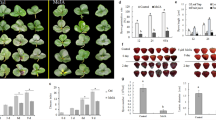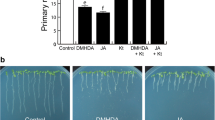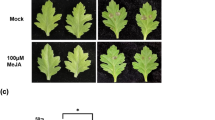Abstract
Key message
Dimethylhexadecylamine, a bacterial compound, promoted strawberry achene germination and a long-lasting effect on plant growth; furthermore, it induced necrotrophic pathogen resistance possibly through crosstalk with the jasmonic acid pathway.
Abstract
Dimethylhexadecylamine (DMHDA) is a volatile compound produced by different beneficial plant bacteria. DMHDA induces growth and activates the jasmonic acid (JA) signaling pathway in plants. In this study, we analyzed the effects of synthetic DMHDA on achene germination, as well as the long-term effect on plant growth and plant pathogen resistance in vitro in strawberry plants. Strawberry achenes treated with 32 µM DMHDA showed a three-fold increase in germination rates compared with untreated achenes, and plants from achenes germinated with 64 µM DMHDA grew four times larger than plants from untreated achenes. When plants were cultured in vitro with DMHDA as a continuous stimulus, they produced 40% less shoot growth but showed an up to four-fold increase in crown weight compared with control plants. DHMDA also induced resistance significantly against the necrotrophic pathogenic fungus Botrytis cinerea in strawberry. Our data showed that the bacterial volatile compound DMHDA regulated achene germination and produced a long-lasting effect on plant growth; furthermore, it induced a defense priming response against a necrotrophic pathogen. Crosstalk between DMHDA and the JA and salicylic acid pathways, as a potential mechanisms of action underlying these effects, is also discussed.




Similar content being viewed by others
References
Badmi R, Zhang Y, Tengs T, Brurberg MB, Krokene P, Fossdal CG, Hytönen T, Thorstensen T (2019) Induced and primed defence responses of Fragaria vesca to Botrytis cinerea infection. BioRxiv. https://doi.org/10.1101/692491v1.abstract
Bailly A, Weisskopf L (2012) The modulating effect of bacterial volatiles on plant growth - current knowledge and future challenges. Plant Signal Behav 7:1–7. https://doi.org/10.4161/psb.7.1.18418
Berendsen RL, Pieterse CM, Bakker PA (2012) The rhizosphere microbiome and plant health. Trends Plant Sci 17:478–486. https://doi.org/10.1016/j.tplants.2012.04.001
Berendsen RL, Vismans G, Yu K, Song Y, de Jonge R, Burgman WP, Burmølle M, Herschend J, Bakker PAHM, Pieterse CMJ (2018) Disease-induced assemblage of a plant-beneficial bacterial consortium. ISME J 12:1496–1507. https://doi.org/10.1038/s41396-018-0093-1
Castulo-Rubio DY, Alejandre-Ramírez NA, Orozco-Mosqueda MC, Santoyo G, Macías-Rodríguez LI, Valencia-Cantero E (2015) Volatile organic compounds produced by the rhizobacterium Arthrobacter agilis UMCV2 modulate Sorghum bicolor (strategy II plant) morphogenesis and SbFRO1 transcription in vitro. J Plant Growth Regul 34:611–623. https://doi.org/10.1007/s00344-015-9495-8
Darwish O, Shahan R, Liu Z, Slovin JP, Alkharouf NW (2015) Re-annotation of the woodland strawberry (Fragaria vesca) genome. BMC Genomics 16:29. https://doi.org/10.1186/s12864-015-1221-1
De Vrieze M, Pandey P, Bucheli TD, Varadarajan AR, Ahrens CH, Weisskopf L, Bailly A (2015) Volatile organic compounds from native potato-associated Pseudomonas potential anti-oomycete agents. Front Microbiol 6:1295. https://doi.org/10.3389/fmicb.2015.01295
Debnath SC (2013) Propagation strategies and genetic fidelity in strawberries. Int J Fruit Sci 13:3–18. https://doi.org/10.1080/15538362.2012.696520
FAOSTAT (2017) Statistical database of the Food and Agriculture Organization of the United Nations. http://www.fao.org/faostat/en/#data. Accessed 26 July 2019
Folta KM, Dhingra A (2006) Transformation of strawberry: the basis for translational genomics in Rosaceae. Vitro Cell Dev Biol-Plant 42:482–490. https://doi.org/10.1079/IVP2006807
Hancock JF (1990) Ecological genetics of natural strawberry species. HortScience 25:869–870. https://doi.org/10.21273/HORTSCI.25.8.869
Hernández-Calderón E, Aviles-Garcia ME, Castulo-Rubio DY, Macías-Rodríguez L, Montejano-Ramírez V, Santoyo G, López-Bucio J, Valencia-Cantero E (2018) Volatile compounds from beneficial or pathogenic bacteria diferentially regulate root exudation, transcription of iron transporters, and defense signaling pathways in Sorghum bicolor. Plant Mol Biol 96:291–304. https://doi.org/10.1007/s11103-017-0694-5
Hernández-León R, Rojas-Solís D, Contreras-Pérez M, Orozco-Mosqueda MC, Macías-Rodríguez LI, Reyes-de la Cruz H, Valencia-Cantero E, Santoyo G (2015) Characterization of the antifungal and plant-growth promoting effects of diffusible and volatile organic compoundd produced by Pseudomonas fluorescens strains. Biol Control 81:83–92. https://doi.org/10.1016/j.biocontrol.2014.11.011
Hernández-Soberano C, Ruíz-Herrera LF, Valencia Cantero E (2020) Endophytic bacteria Arthrobacter agilis UMCV2 and Bacillus methylotrophicus M4-96 stimulate achene germination, in vitro growth, and greenhouse yield of strawberry (Fragaria × ananassa). Sci Hotic 261:109005. https://doi.org/10.1016/j.scienta.2019.109005
Huot B, Yao J, Montgomery BL, Yang-He S (2014) Growth-defense tradeoffs in plants: a balancing act to optimize fitness. Mol Plant 7:1267–1287. https://doi.org/10.1093/mp/ssu049
Ito Y, Maruo T, Ishikawa M, Shinohara Y (2011) Effects of scarification with sulfuric acid and matric priming on seed germination of seed propagation type of F 1 hybrid strawberry (Fragaria × ananassa Duch.). J Japan Soc Hort Sci 80:32–37. https://doi.org/10.2503/jjshs1.80.32
Jacobsen JV, Barrero JM, Hughes T, Julkowska M, Taylor JM, Xu Q, Gubler F (2013) Roles for blue light, jasmonate and nitric oxide in the regulation of dormancy and germination in wheat grain (Triticum aestivum L.). Planta 238:121–138. https://doi.org/10.1007/s00425-013-1878-0
Jisha KC, Vijayakumari K, Puthur JT (2013) Seed priming for abiotic stress tolerance: an overview. Acta Physiol Plant 35:1381–1396. https://doi.org/10.1007/s11738-012-1186-5
Linkies A, Leubner-Metzger G (2012) Beyond gibberellins and abscisic acid: how ethylene and jasmonates control seed germination. Plant Cell Rep 31:253–270. https://doi.org/10.1007/s00299-011-1180-1
Luna E, López A, Kooiman J, Ton J (2014) Role of NPR1 and KYP in long-lasting induced resistance by β-aminobutiric acid. Front Plant Sci 5:1–8. https://doi.org/10.3389/fpls.2014.00184
Macías-Rodríguez L, Quero E, López MG (2002) Carbohydrate differences in strawberry crowns and fruit (Fragaria × ananassa) during plant development. J Agric Food Chem 2002:3317–3321. https://doi.org/10.1021/jf011491p
Montejano-Ramírez V, García-Pineda E, Valencia Cantero E (2020) Bacterial compound N, N-dimethylhexadecylamine modulates expression of iron deficiency and defense response genes in Medicago truncatula independently of the jasmonic acid pathway. Plants 9:624. https://doi.org/10.3390/plants9050624
Orozco-Mosqueda MC, Velázquez-Becerra C, Macías-Rodríguez LI, Santoyo G, Flores-Cortez I, Alfaro-Cuevas R, Valencia-Cantero E (2013) Arthrobacter agilis UMCV2 induces iron acquisition in Medicago truncatula (strategy I plant) in vitro via dimethylhexadecylamine emission. Plant Soil 362:51–66. https://doi.org/10.1007/s11104-012-1263-y
Orozco-Mosqueda MC, Rocha-Granados C, Glick BR, Santoyo G (2018) Microbiome engineering to improve biocontrol and plant growth-promoting mechanisms. Microbiol Res 208:25–31. https://doi.org/10.1016/j.micres.2018.01.005
RainesT SC, Cheng CY, McPherson D, Argueso CT, Kim HJ, Franco-Zorrilla JM, Lóopez-Vidriero I, Solano R, Vaňková R, Schaller GE, Kiebe JJ (2016) The cytokinin response factors modulate root and shoot growth and promote leaf senescence in Arabidopsis. Plant J 85:134–147. https://doi.org/10.1111/tpj.13097
Raya-González J, Velázquez-Becerra C, Barrera-Ortiz S, López-Bucio J, Valencia-Cantero E (2017) N, N-dimethylhexadecylamine and related amines regulate root morphogenesis via jasmonic acid signalling in Arabidopsis thaliana. Protoplasma 254:1399–1410. https://doi.org/10.1007/s00709-016-1031-6
Rigotti S, Gindro K, Richter H, Viret O (2002) Characterization of molecular markers for specific and sensitive detection of Botrytis cinerea Pers.: Fr. in strawberry (Fragaria × ananassaDuch.) using PCR. FEMS Microbiol Lett 209:169–174. https://doi.org/10.1111/j.1574-6968.2002.tb11127.x
Rugienius R, Gelvonauskiene D, Zalunskaite I, Pakalniskyte J, Stanys V (2006) Interspecific hybridization in genus Fragaria and evaluation of the hybrids for cold hardiness and red stele resistance using in vitro methods. Acta Hortic 725:451–456. https://doi.org/10.17660/ActaHortic.2006.725.63
Ryu CM, Farag MA, Hu CH, Reddy MS, Wei HX, Paré PW, Kloepper JW (2003) Bacterial volatiles promote growth in Arabidopsis. Proc Natl Acad Sci USA 100:4927–4932. https://doi.org/10.1073/pnas.0730845100
Singh P, Dave A, Vaistij FE, Worrall D, Holroyd GH, Wells JC, Kaminski F, Graham IA, Roberts MR (2017) Jasmonic acid-dependent regulation of seed dormancy following maternal herbivory in Arabidopsis. New Phytol 214:1702–1711. https://doi.org/10.1111/nph.14525
Szczygiel A, Pierzga K, Borkowska B (2002) Performance of micropropagated strawberry plantlets after planting in the field. Acta Hortic 567:317–320. https://doi.org/10.17660/ActaHortic.2002.567.67
Tagliavini M, Baldi E, Lucchi P, Antonelli M, Sorrenti G, Baruzzi G, Faedi W (2005) Dynamics of nutrients uptake by strawberry plants (Fragaria × ananassa Dutch.) grown in soil and soilless culture. Europ J Agronomy 23:15–25. https://doi.org/10.1016/j.eja.2004.09.002
Thomma BP, Eggermont K, Penninckx IA, Mauch-Mani B, Vogelsang R, Cammue BP, Broekaert WF (1998) Separate jasmonate-dependent and salicylate-dependent defense-response pathways in Arabidopsis are essential for resistance to distinct microbial pathogens. Proc Natl AcadSci USA 95:15107–15111. https://doi.org/10.1073/pnas.95.25.15107
Vázquez-Chimalhua E, Ruíz-Herrera LF, Barrera-Ortiz S, Valencia-Cantero E, López-Bucio J (2019) The bacterial volatile dimethyl-hexa-decilamine reveals an antagonistic interaction between jasmonic acid and cytokinin in controlling primary root growth of Arabidopsis seedlings. Protoplasma 256:643–654. https://doi.org/10.1007/s00709-018-1327-9
Velázquez-Becerra C, Macías-Rodríguez LI, López-Bucio J, Altamirano-Hernández J, Flores-Cortez I, Valencia-Cantero E (2011) A volatile organic compound analysis from Arthrobacter agilis identifies dimethylhexadecylamine, an amino containing lipid modulating bacterial growth and Medicago sativa morphogenesis in vitro. Plant Soil 339:329–340. https://doi.org/10.1007/s11104-010-0583-z
Velázquez-Becerra C, Macías-Rodríguez LI, López-Bucio J, Flores-Cortez I, Santoyo G, Hernández-Soberano C, Valencia-Cantero E (2013) The rhizobacterium Arthrobacter agilis produces dimethylhexadecylamine, a compound that inhibits growth of phytopathogenic fungi in vitro. Protoplasma 250:1251–1262. https://doi.org/10.1007/s00709-013-0506-y
Vicente-Hernández A, Salgado-Garciglia R, Valencia-Cantero E, Ramírez-Ordoica A, Hernández-García A, García-Juárez P, Macías-Rodríguez L (2019) Bacillus methylotrophicus M4–96 stimulates the growth of strawberry (Fragaria x ananassa “Aromas”) plants in vitro and slows Botrytis cinerea infection by two different methods of interaction. J Plant Growth Regul 38:765–777. https://doi.org/10.1007/s00344-018-9888-6
Wang K, Liao Y, Xiong Q, Kan J, Cao S, Zheng Y (2016) Induction of direct or priming resistance against Botrytis cinerea in strawberries by β-aminobutyric acid and their effects on sucrose metabolism. J Agr Food Chem 64:5855–5865. https://doi.org/10.1021/acs.jafc.6b00947
Yang DL, Yao J, Mei CS, Tong XH, Zeng LJ, Li Q, Xiao LT, Sun TP, Li J, Deng XW, Lee CM, Thomashow MF, Yang Y, Hea Z, He SY (2012) Plant hormone jasmonate prioritizes defense over growth by interfering with gibberellin signaling cascade. Proc Natl AcadSci USA 109:E1192–E1200. https://doi.org/10.1073/pnas.1201616109
Zhang G, Jia S, Yan Z, Wang Y, Zhao F, Sun Y (2020) A strawberry mitogen-activated protein kinase gene, FaMAPK19, is involved in disease resistance against Botrytis cinerea. Sci Hortic 265:109259. https://doi.org/10.1016/j.scienta.2020.109259
Zürcher E, Liu J, di Donato M, Geisler M, Müller B (2016) Plant development regulated by cytokinin sinks. Science 353:1027–1030. https://doi.org/10.1126/science.aaf7254
Acknowledgements
We gratefully acknowledge the Valencia-Macias Foundation (México, Grant 5.1) and the Coordinación de la InvestigaciónCientífica UMSNH (México, Grant 2.22) for financial support.
Author information
Authors and Affiliations
Corresponding author
Ethics declarations
Conflict of interest
All the experiments comply with the current laws of Mexico, the country in which they were performed. The authors declare that they have no conflict of interest. This article does not contain any studies with human participants or animals performed by any of the authors. Sponsors did not have any role in study design, collection, analysis, or interpretation of the data, nor in writing the report or in the decision to submit the article for publication.
Additional information
Communicated by J. Van Huylenbroeck.
Publisher's Note
Springer Nature remains neutral with regard to jurisdictional claims in published maps and institutional affiliations.
Rights and permissions
About this article
Cite this article
Hernández-Soberano, C., Valencia-Cantero, E. Dimethylhexadecylamine, a bacterial volatile compound, regulates achene germination, in vitro growth, and defense priming in Fragaria × ananassa. Acta Physiol Plant 43, 20 (2021). https://doi.org/10.1007/s11738-020-03199-6
Received:
Revised:
Accepted:
Published:
DOI: https://doi.org/10.1007/s11738-020-03199-6




